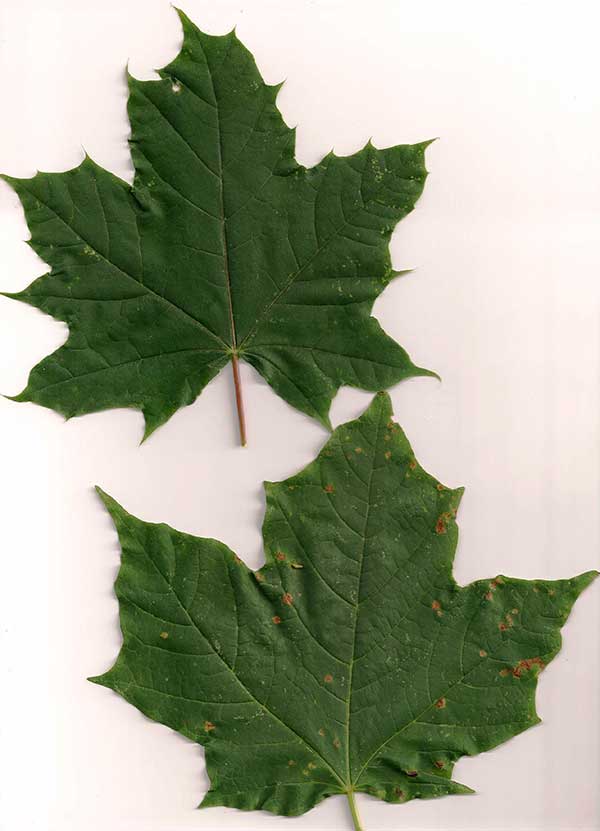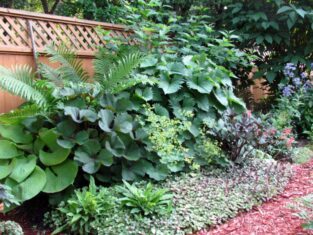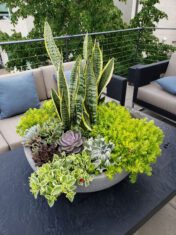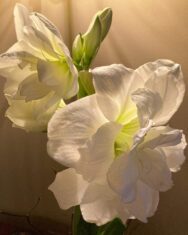
The widely planted Norway maple (Acer platanoides) is not my favourite tree. I wouldn’t mind so much if it would stick to its native range — from Scandinavia to Turkey — but in Canada, it’s quite rightly the poster child for the invasive species lobby. Shade-tolerant Norway maples have thick, dense canopies that cast an impermeable shadow, together with a tangle of surface feeder roots that makes it difficult (if not impossible) for anything to grow underneath them. Worst of all, they are prolific self-seeders, and escaped seedlings crowd out native woodland species and destroy natural habitats. In Canada, the wholesale planting of Norway maples began in the 1950s as a replacement tree for elms (Ulmus americana) that had been killed by Dutch elm disease.
I often wish that Canada would follow the lead of Massachusetts and New Hampshire where the sale of Norway maples is banned. Many well meaning non-gardeners often confuse purple-leaved Norway maple cultivars (such as the over-planted ‘Crimson King’) with our native red maples (A. rubrum), and then naïvely enthuse about their season-long colour. Although my own attitude is admittedly old school, my personal feeling is that maples should only have red leaves in the autumn. As it now stands, arborists estimate that it would take 100 years of conscientious monitoring — and a tremendous amount of money — to eradicate Norway maples from our forests and ravines.
So you can imagine my surprise when I saw them popping up on our currency. The transparent leaf at the top left of every Canadian bank note is a Norway maple leaf. Curiously, the two columns of cascading leaves on the right-hand side of the bills (bordering the transparent section) are sugar maple (A. saccharum) leaves, much like the one we have on our flag. The sugar maple has been the national emblem of Canada for as long as anyone can remember, and it seems extraordinary that this wasn’t more widely understood at the Bank of Canada.
At the time, a senior analyst at the bank made things even worse by explaining that the offending leaf was “a stylized blend of maple species that are native to this country.” Oops! Even a cursory glance at the contours of Canada’s 10 indigenous maple species quickly puts paid to that notion. And this isn’t rocket science: As a rule, sugar maples have three lobes (like the flag) while Norway maples have five lobes with pointy, tapered tips.
Regrettably, Canada has a long history of getting it wrong when it comes to sugar maples. The Royal Canadian Mint described the reverse side of our recently retired penny as featuring “two maple leaves on the same twig.” In fact, the leaves belonged to the London planetree (Platanus ×acerifolia), which explains why they emerged from the twig at alternate points (maples have opposite leaves). Englishman George Kruger-Gray (1880-1943) designed the penny in 1937 and apart from a 12-month respite in 1967 — when the leaves were replaced by Alex Colville’s (1920-2013) rock dove for our Centennial — our one-cent piece was decorated with London planetree foliage for 75 years.

So all things being equal, I guess I shouldn’t have been surprised when the official Canada 150 logo turned out to be yet another five-lobed Norway maple leaf. Undeterred, I resolutely bought myself a Canada 150 T-shirt, and was pleasantly surprised to see that the manufacturer (Joe Fresh Canada) had used a botanically correct sugar maple leaf on its company branding.
Canadian, eh?
Here’s Canada’s 10 native maple species:
Vine maple (Acer circinatum)
Douglas maple (A. glabrum ssp. douglasii)
Bigleaf maple (A. macrophyllum)
Manitoba maple (A. negundo)
Black maple (A. nigrum)
Striped maple (A. pensylvanicum)
Red maple (A. rubrum)
Silver maple (A. saccharinum)
Sugar maple (A. saccharum)
Mountain maple (A. spicatum)










Heavens, I did not know that Crimson King was a Norway maple and to be confused with our native A. Rubrum.
I did have a Norway in my backyard (was there when we moved in), which provided shade for the house. Planted Epimedium, sedums, and mascari underneath. Yes, the pervasive root system was a pain as well as the bags of yellow flowers and seedlings which had to be removed after it had flowered in spring. Had to have the canopy thinned out regularly. It succumbed to the snow storm several years ago and the raccoons (YES!!!) lost their home and the highway to our roof. So it had to be taken out and we, unfortunately, are now without shade. For unsuspecting non-gardeners, ‘Norway’ does not signify, non-native and invasive, but the government should know better. We now also have the scruffy ‘Austrian Pine’ to live with. Hope they don’t put that our coins.
Sugar maples turn the most glorious colours in Fall.
Thank you Stephen for clarifying what the emblem of our home and native land should look like.
Thank you for your informative and generous comments, Joy!
Thankyou for clearing up a question I’ve been having on my own little piece of land in St. Jean Chrysostome, Levis,Québec. I have very old Sugar Maples, striped (Pensylvanicum) Maples and now I will try to identify the others. No wonder it has always been hard to identfy each species as clearly mistakes have been made by supposed experts!
Best Regard as I love your magazine…
I have the dreaded Norway on my boulevard. Oh the mess it makes and the
Grass and flowers that won’t grow there. But it is like a great air conditioner for my house so it cannot be completely hated. Still our politicians should be smart enough to check out the facts before they act…….M
Thanks for this article. I will now rant:
I am so fed up with the city of Montreal which continues to plant Norway maples as street trees as they are cheap and grow fast (for shade). They certainly do grow fast and provide (too much) shade; I unfortunately have one at the bottom of my garden which is a real pest, and a good part of my gardening life is spent removing maple seedlings from beds, paths, etc. all over the garden, as they manage to get through anything in order to take root. And not much will grow in that corner of the garden, certainly nothing bushy and tall enough to hide the back neighbours’ turquoise swimming pool!
I need to water more often than should be necessary, even after rain sometimes, and, combined with the next door’s even taller maple with even longer roots, my vegetable beds need all the roots dug out before each planting season.
I agree it should be illegal to sell Norway maple and any other invasive species found so easily in garden centres who have the cheek to charge money for them!.